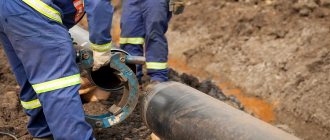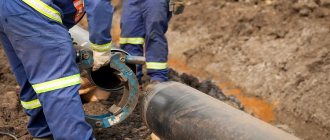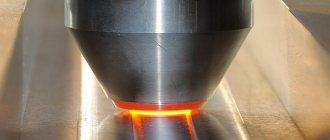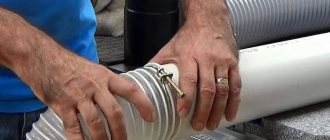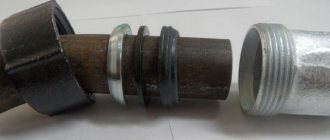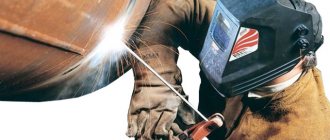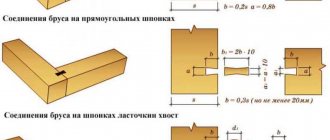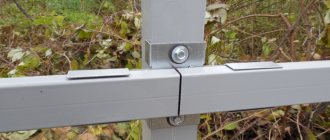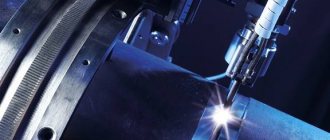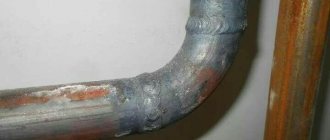For a metal pipeline, only a high-quality and reliable connection is necessary. Insufficient tightness of the system leads to low pressure in it, and, accordingly, to some inconveniences. Many owners of private houses and apartments know only the most popular connection methods: using a weld or thread. Of course, these methods are the most practical, especially if you have the necessary tool at hand. But there are other options for how you can connect metal pipes to each other.
Basic methods of connecting pipes and their descriptions
Before moving on to the immediate topic, you should consider popular methods of connecting metal or steel pipes. These include:
- Connecting metal pipes by welding. It is used most often, but has a number of negative aspects:
- High price. Welding equipment is quite expensive, and its use accounts for half the cost of a welder.
- High complexity of application. Not always, but quite often the welder is faced with a problem in which he simply cannot use welding. For example, in a cramped room or at a high altitude.
- Insufficient speed of welding work. Transportation and preparation of equipment takes a lot of time, so you often have to wait a long time for a welder.
Pipe welding
- Threaded connection.
A set of taps and guides designed for large pipe diameters is required. Now even a set of small taps for a passenger car is quite expensive, not to mention water or gas pipelines. We should also not forget about the need to seal this type of connection. The seal should be changed periodically. Elements for threaded connections
- Coupling connection. Couplings for pipes (especially large diameters) are expensive and are often used to eliminate emergency situations. A more practical option is to install fittings, which will be discussed below.
We recommend watching the video:
Features of dismantling
Gas and water pipelines are usually painted to protect against corrosion. The paint can prolong the life of the system, but it is then very difficult to dismantle the threaded connections. Based on this, it is possible to paint areas with threads no more than once, and when disassembling they must be coated with grease.
If you need to disassemble a section of a structure with multiple painted connecting elements, you must first burn the paint with a blowtorch or clean it off mechanically, for example, with a knife or awl.
The complexity of dismantling greatly depends on the material of the fittings. For example, parts made of malleable cast iron “grow together” with steel pipes much less. Based on this, it is usually possible to unscrew them using a wrench. But it’s unlikely that you’ll be able to unscrew a steel coupling with a wrench.
Note! The key should not be reinforced with a lever, since it can be broken without unscrewing the part.
In addition, heating helps when disassembling the pipeline. For these purposes, it is possible to use a gas burner or a blowtorch. Depending on the diameter of the pipeline, warming up may take 15 minutes. up to an hour. At the same time, during heating, the pipe must be periodically turned so that the seal is burned on all sides.
Types of pipe connections without welding and threading
But if you don’t have welding equipment or a set of taps and drawers at hand, then you should use the following methods:
- Use pipe fittings. Affordable pricing and good quality make these products the most acceptable. The fittings have a rigid structure, which is why they tightly and reliably grip the pipe section, preventing the passage of liquid circulating through the system. The service life of a fitting depends on its manufacturer, so it is best to give preference to products from Switzerland or France.
- Use flanges. The design of the flange resembles a standard clamp, along the inside of which there is a rubber seal. The flange has the following advantages: ease of installation, low cost, durability.
- Apply Gebo coupling. The design of the Gebo coupling is quite simple and consists of three rings (clamping, pressing and sealing), a nut and the flange itself. Installation of this product will not take much time if you know the exact installation sequence. By using the Gebo coupling, you can achieve high tightness of the connection. The service life of the product is long, with the exception of the sealing ring, which has to be changed at certain time intervals.
- Apply the repair and mounting clip. Structurally, this product is made in the form of two parts that must be tightened using bolts. It should be remembered that the repair and installation clip belongs to the category of consumables used in emergency situations. It should not be used for long-term use.
The above connection methods are suitable for pipes with a rigid structure. These can be products made of metal, steel, cast iron or polyvinyl chloride. For profile products that do not require high tightness, the following connection options should be used:
- Crab system. The design consists of brackets and bolts with nuts that act as a tightening element. Using a crab system, you can tighten several pipes, and the strength in these places will be very high. There are several types of crab systems, differing from each other only in the number of holes for the clamp.
Crab connection system
- Clamps for fastening. Universal elements used in almost any construction industry. Using clamps, you can tighten 2 or more profile pipes, and the design, in terms of strength, will not differ too much from a welded one.
How to connect pipes from different materials?
In some cases, it is necessary to connect products that are not homogeneous in material. There are special options for these purposes.
How to connect a polypropylene (plastic) pipe to a metal one?
Many people ask the question: how to connect polypropylene pipes with metal ones? There are several popular methods for this:
- thread;
- flange pipe connection.
In the first case, the coupling of pipes of heterogeneous material is carried out using couplings. One end of such a coupling is equipped with a thread, and the other has a smooth surface for joining with polypropylene.
The flange method involves the use of flanges. This connection is made using studs and bolts.
Note! Flanges are used in structures that are often disassembled during operation.
How to connect metal-plastic pipes with metal ones?
The most popular options in this case are:
- press fittings;
- compression fittings.
In the first case, the connection between pipes of heterogeneous material can be made in two ways:
- sliding press fitting;
- crimp coupling.
It is important to remember that connecting metal-plastic pipes with metal and other pipes of heterogeneous material is quite a responsible undertaking and should be carried out by specially trained specialists. Incorrect installation of the connecting element will lead to an emergency in the pipeline.
Types and advantages of fittings
Why is it worth using fittings and what is the main advantage of this material? The answer is simple: these elements have a simple design, but are practical, they have a long service life and an affordable cost. Without using welding equipment or expensive taps and lerks, the user achieves the same high results using simpler fittings.
Fitting
Fittings are successfully used not only for the installation or repair of pipes; this material is also popular in the manufacture of compression equipment and gas turbine mechanisms. This means that the product creates sufficient tightness with the help of a seal, even in systems with high pressure.
Types of fittings by size and application:
- Direct. This means that the diameter of the product remains unchanged on both one side and the other. Used to connect two identical pipes.
- Adapter fittings. Necessary for connecting two pipes of different diameters. Indispensable, for example, when repairing an old pipeline, where a large number of pipes have different sizes.
- Tees. Allows you to make a branch from the main line without threading or welding.
- Crosses. They have the same purpose as tees, but are capable of dividing the main line into a larger number of branches.
- Fittings. Used as a connection for flexible metal pipes. The fittings are able to create sufficient tightness even when connecting a material that changes its structure.
- Pipe plugs. The main function is to block the end of the pipes.
It should be clarified that the variety of fittings, as well as their manufacturers, allows you to purchase products both for installation outdoors and in an apartment or private house.
What is a Gebo coupling?
Gebo coupling - appearance
A Gebo coupling is a one-way coupling that has elements such as compression rings and a threaded connection. The Gebo double-sided coupling has compression rings located on both sides.
Gebo coupling design
The design of the Gebo coupling implies the presence of a special recess for a rubber seal, which creates a tight connection. The seal is made in the shape of a cone, which facilitates its penetration even into the most inaccessible cracks when tightening the coupling.
Procedure for using the Gebo coupling
In order for the operational life of this product to be as long as possible, it is necessary to know the correct installation process, which will maintain the required tightness of the connection of metal pipes.
- Both pipes should be cut as evenly as possible and its edges should be cleaned, getting rid of small metal burrs. Paint or enamel is also removed, right down to the metal. To do this, you can use fine sandpaper or a special grinder wheel.
- The first thing to put on the pipe is the nut that comes with the coupling. Next, you need to place a cone-shaped ring on the pipe, so that the top of the cone faces the nut.
- The second thing to put on is the pressure ring, followed by the seal. The seal should be turned towards the fitting.
- Next, you should tighten the fitting so that when you tighten the nut, it does not turn. Tighten the nut so that 1-2 threads remain.
The coupling is installed and you should check its quality by supplying water to the system. If drops of liquid appear from under the coupling, it is necessary to tighten the nut slightly and recheck the connection for leaks. If moisture reappears, the coupling should be removed and the area under it re-cleaned.
The main advantages of the Gebo coupling
Gebo couplings are often used due to the practical relationship between pricing and product quality. If installed correctly, the coupling can serve for many years, after which it is enough to replace the rubber O-ring on it and it can be re-installed on the pipeline.
The breadth of application of this product is also appreciated. Like ordinary fittings, the Gebo coupling is used not only in water supply systems, but also in compression systems. To complete the connection it will take a minimum of time, and it does not require the presence of special tools.
Dark Steel
Welding
The main method of connecting metal pipes is welding, electric arc or gas.
- Arc welding is the fusing of electrode material, melted by an electric arc, with insulation of the seam with molten slag - the electrode shell. Enormous currents (200 amperes or more) are provided by a welding transformer.
- Gas welding involves the use of a torch flame to which a mixture of acetylene and oxygen is supplied to melt the edges of the seam. The welding material is provided by welding wire melted in the same flame.
Threads
A threaded connection, unlike a welded one, allows for disassembly. The threads on the edges of the pipes are cut manually, on a screw-cutting lathe or.
To seal threads the following can be used:
- FUM tape. It is inconvenient because it allows leakage with minimal thread reverse.
- Thread - sealant for connecting water pipes does not have this drawback; but not everyone will like the price of 150-200 rubles for 30 meters of thread.
Quick release fittings
The fitting for a metal pipe is a simple design with a union nut, a spacer ring and a rubber or silicone ring gasket. When the nut is tightened, the pipe is securely pressed against the O-ring.
The price of a quick-release fitting starts from approximately 150 rubles; its installation requires careful cleaning of the pipe surface from paint and rust.
Using repair and mounting clips
Repair and installation clip
An easy to use pipe design that is also quite durable and requires no threading or welding. The repair and installation clip consists of two metal parts, a seal and 4 tightening bolts. Unfortunately, it is not recommended to use the clip for a long period of time - this type of fitting is designed to quickly eliminate emergency situations.
Installing the clip (along with stripping) will not take much time. But the connection must be made carefully, and after installation it is necessary to check its quality.
Sequence of use of the repair and installation clip
- The clip can easily be used to close, for example, a crack in a pipeline without threading or welding. It is not suitable for connecting two pipes. Therefore, after detecting a crack, the area around it should be thoroughly cleaned using fine sandpaper. After cleaning, a clean and smooth surface should be formed on which the seal will fit tightly.
- Next, put a rubber pipe seal over the damaged area so as to completely cover it. The slightest gap will lead to fluid leakage.
- Now you should put two halves of the repair and installation clip on the seal and tighten them with four bolts. There is no need to tighten too much to avoid damaging the threads.
- Let in the liquid and check if the connection is tight enough. If necessary, tighten bolts or nuts.
The simplicity of this method makes it very popular. The second positive quality is that the repair and installation clip has a low cost.
Correct threaded connection
A threaded pipe connection is a detachable joint made using a spiral or screw surface called a thread. This is one of the most common connections due to its tightness, reliability and ease of installation. To implement it, you will need to tighten two elements that have threads of a suitable diameter. To separate the joint you will need to perform the steps in the reverse order, that is, simply unscrew the parts.
Pipe sections with threaded connections are usually installed where periodic inspection is possible. This is due to the fact that over time, for various reasons, the thread may “loose” and the fastening will lose its tightness. Then repair work will be required. Threads are usually rolled onto pipes using special equipment, but they can also be cut manually using a die.
The operation is performed as follows:
A part of the required size is cut with an allowance for the threaded part
The pipe is secured in a vice so that the possibility of twisting is completely eliminated. Carefully and carefully, the die is attached to the end of the part. Even a slight distortion when putting on the die is unacceptable, otherwise the thread will turn out crooked. The required number of turns is cut
To facilitate the procedure, the pipe can be lubricated with machine oil. A stuck die is most likely being slowed down by chopped chips. To remove it, one revolution is made back, after which work continues.
If you have to make threads on a pipe located too close to a wall or other plane that does not allow you to make a full rotation of the tool, die holders with a ratcheting mechanism are used.
When making a threaded connection, a seal is usually required. This can be any plumbing fixture
Most plumbing connections between pipe sections are quite simple. If you follow the instructions correctly, they can be completed efficiently and quickly enough. The main thing is to correctly choose the appropriate type of connection and select all the necessary elements for it. In this case, you can be confident in the reliability and strength of the completed pairing.
Flange connection – convenient installation and affordable price
A flange connection is used even when it is necessary to join a plastic and metal pipe without threading or welding. This connection of metal pipes without welding is made using bolts and has high strength and tightness.
Flange
The design of the flange for the pipeline is simple: 2 metal disks, each of which fits a pipe. There is a rubber seal between the discs. To connect the structure, there are bolts on which nuts are placed on the other side.
This connection of steel pipes is reliable and durable and can be used for several decades. But after certain time intervals (1-3 years), the flange must be maintained and the quality of the seal checked.
Sgony
Non-specialized information
The squeegee is also a connecting fitting, which is essentially a short tube. On one side, the part has a small thread for connecting to the fitting. At the other end there is a long thread on which the locknut and the entire coupling for connecting the pipes are placed.
It is necessary that the product has a sufficiently long thread, because if the parts do not fit in the area with the thread, it will be necessary to increase the distance between the connected ends of the pipe and the pipe, which will reduce the strength of the connection.
It must be stated that this connecting element is much more often used for water pipes. For this reason, it lacks good anti-corrosion protection. The most common types of surges are:
| Nickel plated | They are much more often used in residential premises in order to give the pipeline a more aesthetic appearance. It goes without saying that the price of such fittings is higher than simple steel ones. |
| Galvanized | Used in areas where the system is exposed to atmospheric phenomena. |
| Steel | Much more often they are used for pipelines that are laid in the ground. They are painted to protect against corrosion. |
In accordance with GOST 6357-73, the dimensions of pipe bends can be as follows:
| Product length, mm | Inner diameter, mm | Length of long threaded section, mm | Length of small threaded section, mm |
| 150 | 50 | 65 | 17 |
| 130 | 32 | 55 | 13 |
| 110 | 15 | 40 | 9 |
In addition, there are some intermediate sizes. Naturally, connecting parts are selected in accordance with the diameter of the pipeline.
Connection Features
The instructions for assembling the pipeline are as follows:
- First of all, a coupling is screwed onto the pipe.
- After this, the product is screwed with the small side into the connecting fitting (in some cases, the squeegee is connected directly). The connection must be strong, so you need to tighten the parts until they stop.
- A lock nut must be screwed onto the long end of the part..
- Then, from the side of the long threaded section, you need to screw the connecting fitting until it stops.
- Then you need to bring the end of the drive to the pipe and unscrew the coupling so that it slowly begins to move onto the pipe . The more correctly the axes of the parts coincide, the easier it is to make the connection.
- Then the fitting is locked with a lock nut; to do this, the lock nut must be tightened to the coupling, leaving a distance of a couple of centimeters . The space that appears between the parts must be filled with strands of flax, which are wound in the direction of rotation of the nut. Then the locknut is tightened until it stops, as a result of which the connection will be sealed and water will not be able to leak through it.

